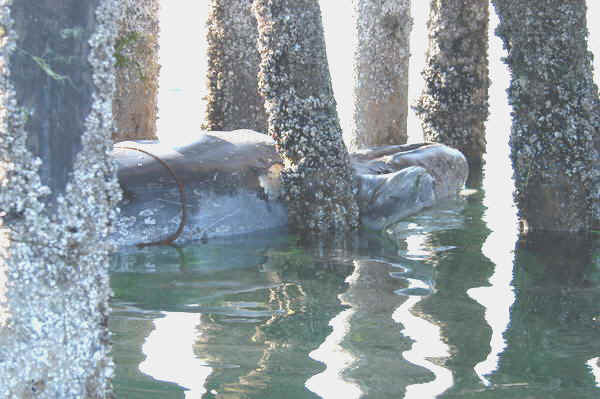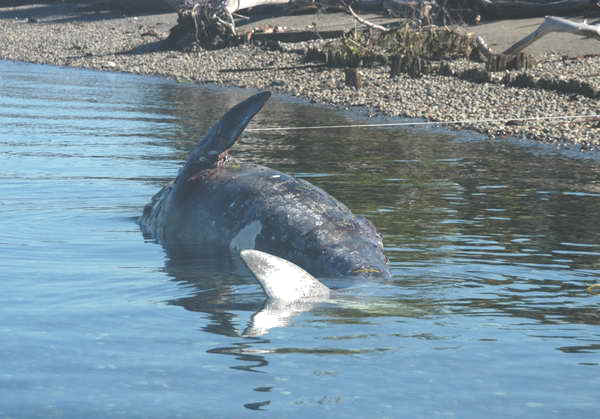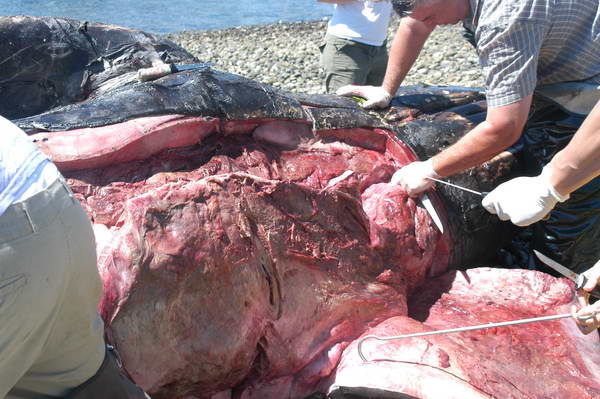A young gray whale was found dead in southern Puget Sound on 24 July and an exam completed on 26 July. This represents the 10th gray whale stranding in Washington State this year. This report provides some of the background and details of this stranding.
On 23 July 2005 a boater spotted a dead whale trapped in pilings from an old dock north of Steilacoom in southern Puget Sound. The report was initially called in to the Whale Museum that day and then relayed to Cascadia Research who contacted the reporting party. John Calambokidis of Cascadia Research examined the whale on 24 July 2005 and determined it was a small juvenile gray whale. Permission was arranged on 25 July for moving the whale to the shore near the dock and for an examination to be conducted there the following day. The move was conducted by two of Cascadia’s rigid-hull inflatable boats on 25 and 26 July 2005. The whale was wedged between pilings and was hard to remove on initial attempts.
An examination of the whale was conducted on the beach during the afternoon and evening of 26 July by biologists and veterinarians with Cascadia Research, National Marine Fisheries Service, Washington Department of Fish and Wildlife, British Columbia Ministry of Agriculture and Food. Only preliminary results of the external examination are available at this time and results from tests of tissues may not be available for several weeks.
The whale was a 6.6 m (22 feet) male gray whale and is the smallest of the 10 gray whales that have stranded in Washington this year. Based on size is likely a weaned calf born early this year. Gray whale calves are typically born around January on their winter breeding grounds in Baja, Mexico and usually wean from their mothers in August on their northern feeding grounds. There have not been any reports of a mother and calf in southern Puget Sound.
The normal girth, blubber thickness, and presence of a high level of oil in the blubber indicated this animal was not in poor nutritional condition when it died, which is different from many of the other gray whale strandings. The necropsy went extremely well, the degree of decomposition in different tissues was highly variable but many organs were not heavily decomposed indicating the animal had died not long before the initial report. This means the animal either became trapped in the pilling while alive and died as a result, or had died only shortly before drifting and becoming trapped. At this point we suspect the animal became trapped while alive then died. There were indications of fractures to both vertebra and ribs but these appeared to have occurred after death. Because the animal was thin and results of other tests are not available, it is possible other factors were involved as a cause of death.
This is the 10th confirmed stranding of a gray whale this year in Washington State. Every year from 1 to 28 gray whales wash up dead in Washington State. The average has been a little over four a year, so this is above normal. It remains well under the more than 20 strandings that occurred in 1999 and 2000 when a major mortality event occurred all along the range of the gray whale from Mexico to Alaska. The gray whale population had been recovering from commercial whaling and had increased to over 20,000 animals by the late 1990s. The mortality event in 1999 and 2000 reduced that population down to an estimated 17,000. Since 2000, mortality has been low.
Contacts for additional information: John Calambokidis, Cascadia Research, 360-943-7325.


